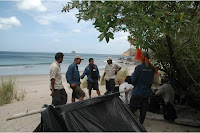Paso Pacifíco board member, Rick Smith, has written a new piece for National Parks Traveler about the Hawksbills we’re tracking:

The rangers who discovered the two turtles kept them on the beach for two days, keeping their heads covered with wet towels and occasionally pouring water over their backs, so these unwitting reptilian volunteers could help scientists learn more about their dwindling species.
During the second day, a turtle expert from a regional program known as Project Hawksbill came and in cooperation with Paso Pacífico and the employees of MARENA (The Ministry of Natural Resources in Nicaragua) affixed a digital transmitter on the shells of the turtles using a special epoxy. So rigged, these transmitters should allow the turtles’ travels to be tracked when they come to the surface to breath during the next year or two.
This transmitter tagging was no small event. Children were released from school to observe the installation. Officials from the Ministry of Natural Resources were there, as were representatives of the media. It was very emotional when the children applauded when the second turtle returned to the sea after being liberated. I am sure none of them will become turtle egg poachers in the future.
 |
| Ranger Meeting |
Rick’s piece also describes the turtle ranger program he helped us launch:
Everyone recognized that the real heroes of this event were the rangers who work for Paso Pacífico, a non-profit organization founded in 2005 to focus on restoring and protecting the endangered ecosystems along the Pacific slope of Central America.
…
These rangers patrol unprotected beaches to protect turtle nests from poaching….All were very enthusiastic about what they were doing. They report that the number of egg poachers is slowly declining and that the incentive program is having a positive effect.
Read the whole piece here:
Exporting “Rangering”: Working To Help Nicaraguans Safeguard Rare Hawksbill Turtles